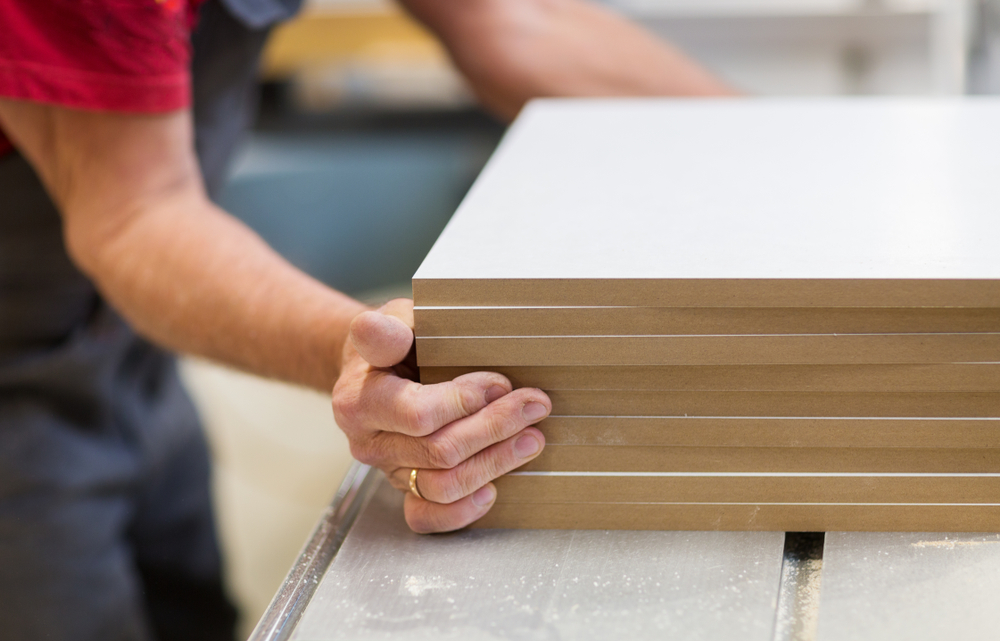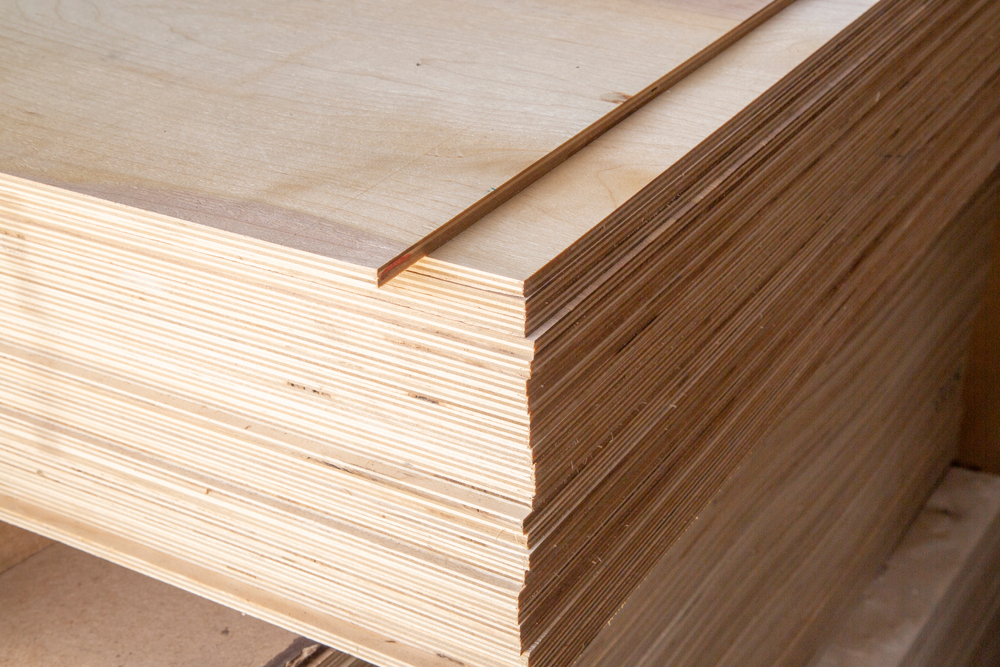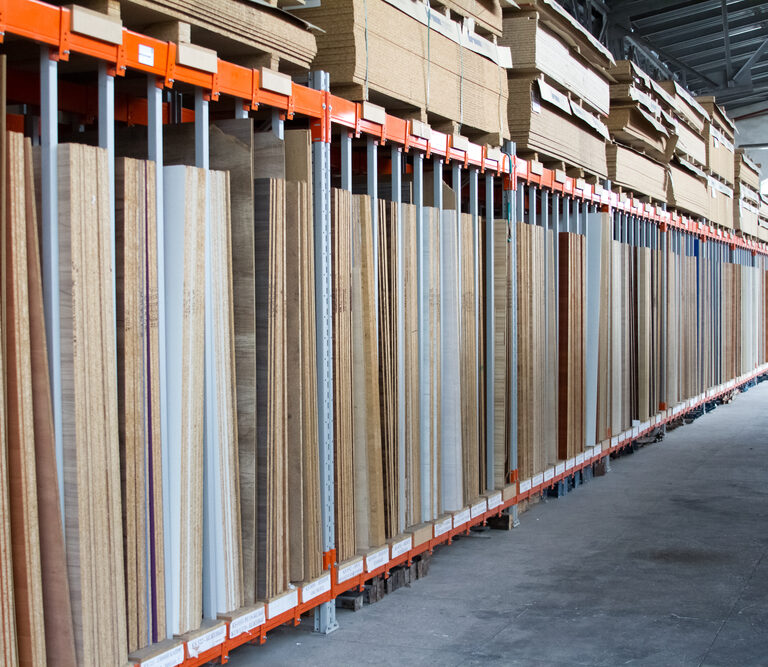Whether you’re working on some home improvements or creating a piece of furniture or shelving, selecting the right materials is essential. However, walking into a local hardware store can be overwhelming because so many different products are available.
Two of the most common materials to use on a home project are MDF and plywood. The is because these products provide more bang for your buck than lumber and are useful in a variety of applications.
As you select your materials, you’ll want to be aware of this MDF vs. plywood comparison to ensure you choose the option that best suits your needs. Here’s a look at the pros and cons of these wood types.
What Is MDF?
MDF, or medium-density fiberboard, is an engineered wood made from broken-down softwood and hardwood fibers. These fibers are mixed with resin and wax, and heat pressed to create boards that look like a solid piece of material.
A completed MDF piece is uniform, free of knots, and smooth, making it an attractive material to use on things like cabinets, bookshelves, crafts, and moldings.
The Advantages of MDF

MDF features numerous benefits when using it for applications around the house or on a job site. These advantages make it worthwhile to consider using MDF on your next project, particularly if you can find it at a reasonable price.
Inexpensive
First and foremost, MDF is an inexpensive product that you can generally find for lower prices than plywood. It’s also cheaper than many other engineered composite kinds of wood like OSB, LVL, LSL, and CLT. The economic aspect of MDF is one of the things that makes it so attractive to do-it-yourselfers.
Environmentally Friendly
Since manufacturers create MDF using recycled wood and scraps, it’s an environmentally-friendly product that doesn’t require cutting down new trees. MDF generally uses wood that would otherwise end up in the landfill. Making use of this recycled wood is good for the planet and keeps the product’s prices down.
Easy to Cut and Shape
MDF has smooth edges that make it easier to cut. Saws move through the material quickly with very little kickback, which is an excellent feature for less experienced woodworkers. This construction is also great for creating designs in the wood or when cutting intricate patterns.
Consistent Construction
Unlike plywood, MDF has consistency and uniformity and doesn’t produce voids or splinters on its edges. These features make the product better for precision work. The consistent texture also ensures you know what the final product will look like because every MDF piece has the same appearance.
Takes Paint Well
Because MDF has a smooth surface without wood grain, it takes paint incredibly well. You won’t have to worry about sanding because the pieces come pre-sanded and ready to paint. Keep in mind that you’ll want to prime the surface before painting for the best results.
Dense and Strong
Although it isn’t as strong as plywood, MDF is a durable material when used under the right circumstances. You won’t want to use MDF for industrial or commercial structural applications, but it is useful for light, at-home construction, and furniture.
The Disadvantages of MDF
Although MDF has many positives, it, as you might expect from one of the least expensive wood types on the market, also has some drawbacks that you’ll want to be aware of before making your purchase.
Doesn’t Hold Fasteners Well
Because MDF is a soft material that uses wax and resin binders in its construction, it doesn’t work very well with fasteners like screws. Screws can tear the wood fibers apart and, in some cases, split the wood in the process.
It’s possible to reduce the odds of the wood splitting by drilling pilot holes that are 85-90% of the screw size. You could also use a trim nailer instead of a drill. You’ll want to use wood glue in addition to screws or nails because the wood doesn’t hold these fasteners very well either.
Heavy Material
It won’t take long to notice that MDF is a heavy material that is denser than plywood. In fact, its density ranges from 680 to 830 kilograms per cubic meter. While the actual weight depends on the manufacturer and the materials used, an average quarter-inch-thick sheet of 4×8 MDF weighs about 36 pounds. This additional weight makes the product more challenging to lift and clamp when putting your creation together.
Creates VOCs
A significant issue with MDF is its toxic properties. Formaldehyde and other carcinogenic chemicals are used in the product’s construction, creating harmful dust when cut. You’ll want to cut your MDF outside or in a well-ventilated room to keep yourself safe. It’s also worth noting that the tiny scraps used in MDF’s construction create more dust than other wood types.
Not Weather Resistant or Waterproof
One of the most significant issues associated with MDF is that it soaks up water like a sponge. As a result, the product isn’t useful in an outdoor setting because it absorbs rainwater, which weakens it in the process. The material is durable, but its inability to withstand water makes it a dealbreaker in some situations. Keep in mind that water-resistant MDF is available but is more expensive.
High Maintenance
Overall, MDF is a pretty high-maintenance material because even minor blemishes aren’t easy to repair. When working with a solid piece of wood, you can quickly fill a crack or chip, but MDF doesn’t react well to these methods, and you can’t cover the damage with a quick paint job.
What Is Plywood?
Much like MDF, plywood is engineered wood. The difference is that plywood is created by binding sheets of veneer wood together rather than using wood fibers. The veneer wood is made by peeling thin layers of wood from logs and then cutting the pieces further to meet the plywood’s required dimensions.
The wood pieces are then dried, patched, and glued together before entering a press and baking to create a wood panel. Plywood comes in varying grades and has a visible wood grain, giving it a far different appearance than MDF.
Plywood comes in many different forms, as there are hardwood and softwood versions. It all depends on the type of tree used, but the wood’s thickness is more important than the type of wood.
The Benefits of Plywood

Almost every home in the country features plywood, so there must be something to this material. However, it’s a good idea to learn about the benefits of using this product before you begin.
Very Durable
When buying wood for construction, durability is perhaps the most crucial aspect. Plywood is a strong material that comes in various thicknesses, so you can select the grade of wood you required based on your project. Unlike MDF, plywood offers some flex, too, so you can bend it to create curves and don’t have to worry about it warping.
Doesn’t Soak Up Water
Hand-in-hand with its durability is the fact that plywood doesn’t soak up water like MDF. A little bit of water can ruin MDF in a matter of minutes, but plywood can resist this moisture and will stay intact while you wait for it to dry out. While the material isn’t completely waterproof, it can withstand exposure enough for use in outdoor applications.
Takes Stain Well
Plywood isn’t the best material for painting, but it looks great with a wood stain over top of its natural wood grain. When choosing between plywood and MDF, how you plan to color the material could be central to your final decision.
Holds Screws Tightly
You’ll find that plywood does an outstanding job of holding screws and other fasteners, making it easier to attach boards when creating an object. The varying wood grains in the product give the screws something to hold onto, ensuring the fasteners don’t slip or wear on the material over time.
Lightweight
Plywood is often a fair bit lighter than MDF, making it easy to lift and use on projects that require you to elevate the material. Of course, the actual weight depends on the type of wood, but an average quarter-inch-thick piece of 4×8 hardwood plywood weighs 24.5 pounds, while a softwood piece is about 22 pounds.
The Drawbacks of Plywood
Despite all of its positives, plywood has some negatives that you should be aware of before selecting it for your next at-home project.
Costs More
If cost is the deciding factor for you, plywood likely won’t be your choice. That’s because plywood is more expensive than MDF, and its price increases even further as you start getting in the high grades of material.
Variance in Construction
There’s no uniformity to plywood because every piece includes several layers of wood veneers. Therefore, you won’t get two pieces that look alike, as each will have different grains, knots, and other aesthetic differences. These differences in appearance could create challenges when making furniture that requires a uniform appearance.
Splinters on the Edges
When cutting plywood, you’ll notice that it splinters at its edges. The result is a material that’s doesn’t respond well to fine work or intricate designs. The edges might also develop voids when cut that can hinder its durability. You might have to use banding or molding on the edges of your plywood, too.
Final Thoughts
The wood you choose for your project will largely depend on what the job entails. For anything structural or furniture that could experience moisture exposure, plywood is the way to go. For interior shelves and fittings that don’t require much for fasteners, using MDF can save you some money. Look at your project’s needs and budget and take the pros and cons of these two wood types into account before making your decision.
